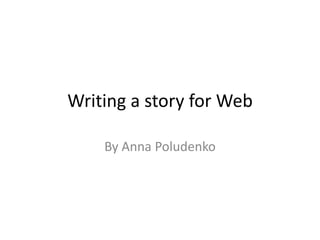Writing a story for web car
- 1. Writing a story for Web By Anna Poludenko
- 2. IŌĆÖll have my article pulled together in no time
- 3. The Seven Deadly Sins ŌĆó 1. Pride ŌĆó 2. Rush ŌĆó 3. Comprehensive search VS focus ŌĆó 4. Apathy ŌĆó 5. DonŌĆÖt use the same source for every search ŌĆó 6. DonŌĆÖt be narrow minded ŌĆó 7. Ignorance
- 4. Story-building Steps 1. Listen to find the story (listen VS monitor?) 2. Where is it likely to be? 3. What search tool might provide it? (search engines, subject directories) 4. Specify the field
- 5. I FAILED TO SEE HOW FILMING A CAT MAKES ME A CITIZEN JOURNALIST
- 6. The Invisible or Cloaked Web ŌĆó Search engine index ŌĆō less than 10% of the web. ŌĆó Google ŌĆō less than 6% of all available.
- 7. Use primary search engines to locate the database (I want jobs in Honolulu) Search within those database.
- 8. Writing= story telling ŌĆó Hard news - event driven ŌĆó Profile ŌĆō microcosmos ŌĆó Trend stories ŌĆō light features, hard news, soft news ŌĆō changes in demographics. ŌĆó Opinion ŌĆō reviews, editorial, columns ŌĆō people from the community who has something interesting.
- 9. Structure I 1. The Inverted Pyramid ŌĆó - most important ŌĆó - details later ŌĆó - critics
- 10. II ŌĆó Top (lead ŌĆō hard news) ŌĆó Transition ŌĆó Typical chronicle ŌĆó Narrative
- 11. III ŌĆó The anecdotal lead - mini-story
- 12. REPORTING
- 13. Lead ŌĆó Intrigue! ŌĆó Straight, ŌĆó Feature ŌĆó Dangerous ŌĆó Prohbited
- 14. Straight ŌĆó Summarize the information. ŌĆó Quick into the story. ŌĆó Blind ŌĆō drop important details but leave something the most important. ŌĆó The basic building block but doesnŌĆÖt have to be boring. ŌĆó Which details to use in the first paragraph and which to skipp.
- 15. Feature ŌĆó Anecdotal ŌĆō quick story that demonstrates. ŌĆó Narrative ŌĆō give a sense of a place people ŌĆó Scene-setter ŌĆō description of where the event is taking place. ŌĆó Significant detail. ŌĆó Word play.
- 16. Dangerous ŌĆó The story is supposed to answer the questions not ask them. - Mishandle the question - the quote - the topic - Ineffective quotes to loose its power. -General description
- 17. Prohibited Leads ŌĆó They are heeeere ŌĆó Its official ŌĆó He leaned back in his chair ŌĆó The dictionary definition.
- 18. Nut graph ŌĆó The main theme statement of the story : here is what my story is about to get my information out straight forward. Followed by paragraphs that answer key questions
- 19. Transition ŌĆó Signals that the story is moving from one point to another
- 20. The three-legged stool ŌĆó Statistics ŌĆó Example ŌĆó Quote
- 21. Ending ŌĆó Circling back ŌĆó Looking forward





















